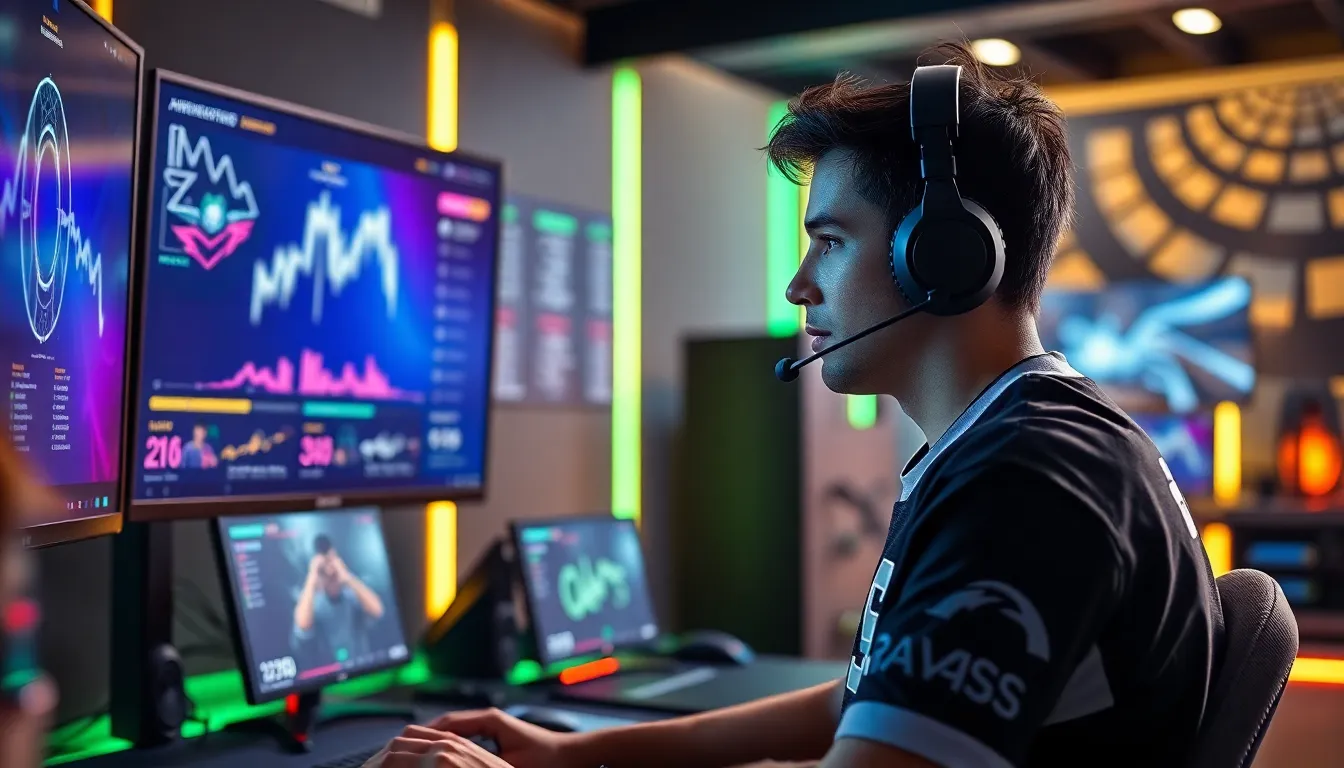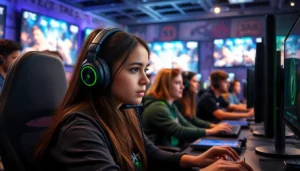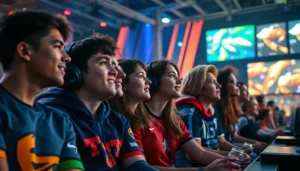In the fast-paced world of competitive gaming, every move counts. Players aren’t just battling for glory; they’re strategizing, analyzing, and outsmarting their opponents with the precision of a chess grandmaster on caffeine. Competitive gaming analysis has become the secret sauce that separates the champs from the chumps. It’s like having a personal coach who whispers, “Hey, maybe don’t run into that grenade next time.”
But it’s not just about stats and numbers. It’s about understanding the game’s nuances, spotting trends, and predicting the unpredictable. Whether you’re a seasoned pro or a curious newbie, diving into the depths of competitive gaming analysis can elevate your gameplay and keep you one step ahead. So grab your controller, and let’s unlock the secrets behind the pixels.
Table of Contents
ToggleOverview of Competitive Gaming Analysis
Competitive gaming analysis encompasses a systematic evaluation of gameplay. Players leverage data to identify strengths and weaknesses. Understanding match dynamics transforms approach and strategy.
Insights from analytics reveal player performance trends. Tools like heat maps and statistical models present actionable intelligence. Games often include vast amounts of data, such as kill-death ratios and objective completions. Analyzing these metrics allows players to refine their tactics.
Feedback from past matches informs future decisions. Players can pinpoint specific skills needing improvement. Emphasis on adaptability and strategy enhances competitive edge.
Communities and forums often engage in discussions about effective analysis techniques. Players exchange tips, resources, and personal experiences. Networking enhances understanding of game mechanics.
Technological advancements drive the growth of analysis tools. Streaming platforms allow easy access to professional gameplay, showcasing high-level strategies. Players mimic successful techniques to elevate individual performance.
In-depth analysis encourages both collaboration and competition. Frequent practice combined with analysis leads to continuous improvement. Competitions increasingly recognize analytical skills as essential for success.
Key Metrics in Competitive Gaming

Evaluating competitive gaming involves a range of crucial metrics that inform players and teams about their performance.
Performance Player Metrics
Kill-death ratio (K/D) stands as a vital statistic in individual performance analysis. Tracking kills and deaths provides insight into a player’s ability to secure eliminations while minimizing losses. Average damage per round highlights overall effectiveness when facing opponents. Additionally, objective completions reflect a player’s contribution to team goals, showcasing an understanding of game mechanics. Win rate offers a broader perspective on success across various matches. Metrics like headshot percentage and first kill success further refine player assessments, allowing gamers to adjust tactics effectively based on analytical feedback.
Team Performance Metrics
Communication efficiency ranks as a critical factor in team dynamics. Coordinated strategies take precedence in competitive environments, driving success through synergy among players. Kill participation ratio measures how often players contribute to team eliminations, illustrating team collaboration on the battlefield. Map control statistics shed light on a team’s dominance in key areas, influencing control over objectives. Objective-related metrics, such as capture and defense rates, emphasize teamwork during match play. Overall win rate within the team context indicates consistent performance across competitions, guiding future strategies and planning.
Tools and Techniques for Analysis
Competitive gaming analysis involves various tools and techniques designed to enhance player performance and strategic understanding. Employing the right methods and software helps gamers achieve their goals.
Data Collection Methods
Data collection in competitive gaming uses several methods for gathering valuable insights. Players often utilize in-game analytics to track performance metrics, capturing data points like kill-death ratios and objective completions. Direct gameplay recordings provide a visual reference for self-analysis, allowing players to review their decision-making processes during matches. Observational data collection from tournaments captures team dynamics and communication patterns, highlighting effective strategies used by top players. Surveys and feedback forms can also gauge player sentiment and effectiveness of various tactics. By combining these diverse data collection approaches, gamers can create a comprehensive picture of their performance.
Analysis Software and Platforms
Numerous software solutions and platforms facilitate competitive gaming analysis. Tools like Overwolf and Mobalytics offer players analytics that break down critical gameplay metrics, including K/D ratios and damage output. Streaming services also provide access to professional gameplay, enabling players to learn and adapt strategies from experts. Gaming-specific platforms such as Discord foster community discussions around various analysis techniques, allowing players to share insights and advice. Third-party applications like Tracker Network compile statistics across multiple games, offering comprehensive insights for individuals and teams. These analysis resources empower players to enhance their competitive edge through informed decision-making.
Case Studies in Competitive Gaming
Competitive gaming analysis showcases valuable insights through real-world examples and case studies. Examining specific games highlights the principles and strategies that drive success in this arena.
Analysis of Popular Games
Fortnite reveals unique patterns in player behavior through heat maps. Top players often utilize high-ground strategies leading to increased survival rates and kill counts. Apex Legends illustrates teamwork’s significance; coordinated squads dominate by effectively using legend abilities. Call of Duty illustrates how weapon choice impacts performance metrics. The game’s analytics demonstrate that familiarity with loadouts can enhance kill-death ratios and objective completion percentages. Each game’s data features distinct trends that contribute to understanding effective strategies in competitive play.
Lessons Learned from Competitive Tournaments
Major tournaments offer essential lessons in competitive gaming performance. Elite teams frequently adapt strategies mid-game based on in-depth analysis and real-time data. Players who review past tournament gameplay identify winning tactics more effectively, enhancing overall teamwork. Focusing on communication efficiency emerges as a critical factor for triumphant squads. Following tournaments, analyzing common mistakes and tactical failures provides learning opportunities for future competitions. Each tournament’s insights contribute to evolving competitive strategies and reinforce the importance of ongoing analysis in refining player performance.
Future Trends in Competitive Gaming Analysis
Emerging technologies shape the future of competitive gaming analysis. Artificial intelligence (AI) enhances data processing, allowing players to receive real-time feedback and refined performance metrics. Machine learning algorithms identify patterns in gameplay, offering tailored strategies for players to adopt.
Collaborative tools are set to redefine communication among teams. Platforms that integrate voice chat with analytical tools facilitate seamless discussions around tactics and strategies during matches. Gamers who use this technology can analyze gameplay while sharing insights, which strengthens teamwork and collaboration.
The focus on personalized analytics continues to rise. Players increasingly turn to custom dashboards that track individual stats and progress over time. These dashboards can surface weaknesses, creating targeted training regimens for improvement.
Data privacy concerns play a significant role in shaping competitive gaming analysis. As players share their gameplay data, maintaining anonymity and security becomes crucial. Companies must ensure robust data protection measures, building players’ trust while gathering actionable insights.
Virtual and augmented reality (VR/AR) technology introduces new dimensions to analysis. These immersive experiences help players visualize in-game scenarios and practice tactics. Training simulations developed with VR/AR provide environments for honing strategies without the pressure of live competition.
Engaging with community-driven resources remains a priority. Forums and social media platforms emerge as vital spaces for discussing trends and innovative analysis techniques. Players who actively participate in these communities gain early access to evolving strategies and collaborative learning opportunities.
The integration of streaming services into analysis tools gains momentum. Watching professional gameplay alongside analysis features offers viewers context on strategies and decisions made by top players. Streamers frequently highlight their thought processes, providing valuable lessons for aspiring gamers.
Competitive gaming analysis is a game-changer for players seeking to elevate their performance. By leveraging data and insights players can refine their strategies and enhance their skills effectively. The integration of advanced tools and community support empowers gamers to make informed decisions, fostering both individual growth and team success.
As technology continues to evolve the landscape of competitive gaming will also shift. Embracing these advancements will be crucial for players aiming to stay ahead of the competition. The journey of improvement is ongoing and those who commit to analysis will find themselves better equipped to face the challenges of the gaming arena.


